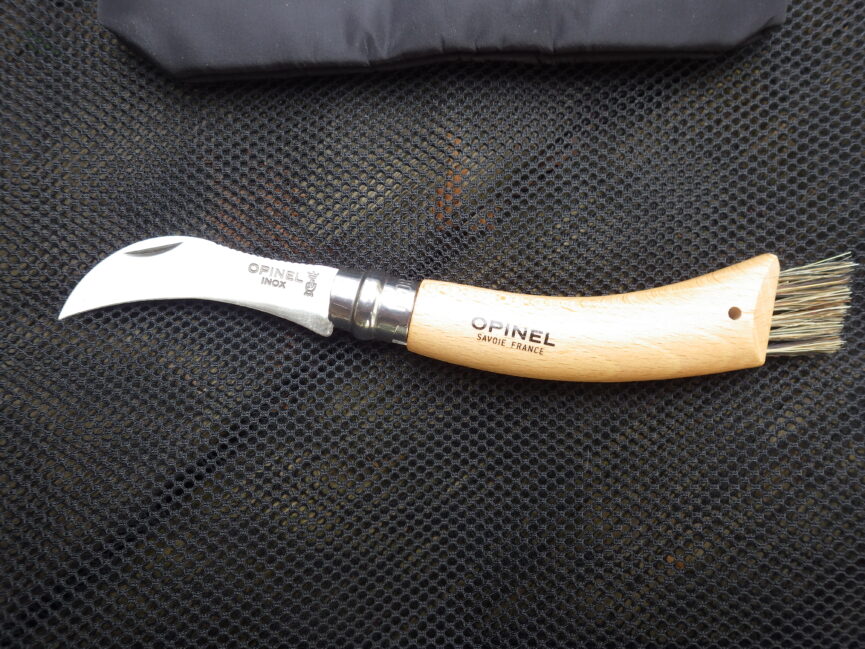The first knife I ever carried was a small, bone-handled pocketknife with a single two-inch blade. This occurred a couple years before I even started school, and I was allowed to carry it. I looked upon it as a status symbol, because just about everyone I knew carried a pocketknife, even my mother. It is a handy item to have readily available, especially on a farm. And yep, folks, back then, I always carried a pocketknife even in school as it was a natural part of my dress and a necessary “working tool”, a fact I continually follow to this day.
Of course, the way of the world has changed and when required to not have any sort of knife on my person, such as for air travel, I do follow the rules, although I’m none too comfortable with such. I’m left with the feeling something important if ever needed is missing.
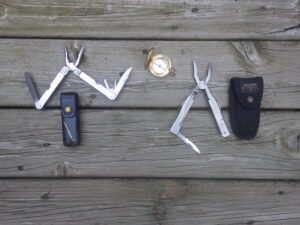
Folding knives have been around since the Early Iron Age and are a very safe and convenient way to carry a sharp blade, which folds into the handle. It was a necessity for the ancient Romans and even Vikings, for a variety of tasks which didn’t require a large, fixed blade. The term “penknife” came about for small folding knives used to sharpen the quills on feathers which were used for dipping in ink and writing and is a term which remains in effect for small folding knives. The term “pocketknife” was, of course, created when pockets on garments eventually came into vogue and became a real convenient way to carry a folding knife.
I grew up calling small folding knives “jackknives” and it is a term which came about during the American Civil War. Per the dictionary, it can be applied to any folding knife, but to me, a jackknife relates to smaller, pocket versions.
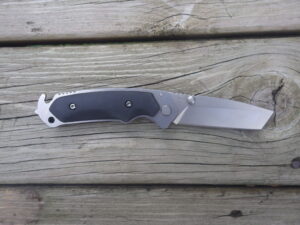
folding knife w/lockblade
Folding knives with a “lock-blade” have been around since the 15th Century, and they allow the blade to remain safely “fixed” when cutting matters. I can remember getting careless and having a sharp blade fold down onto my fingers holding the handle of a non-lock-blade knife. Trust me, folks, when I say it is an educational moment!
It was discovered that folding knives could not only have a blade or two, but other accouterments as well. Enter one of my favorites, the Swiss Army Knife, and the genuine articles are only made in Switzerland. You name it, and it can be had on a Swiss Army Knife, up to the point of being unbelievable, but obviously useful and necessary in the eyes of some. Personally, I prefer just the simple basics, which entails a (sharp) blade, saw, screwdriver/bottle-opener, can opener, and yep, folks, I’ve even used the corkscrew to “pull a cork” near a crackling campfire!
A truly filled-with-amazing “do-dads” folding knife I own, was made by the Marble Knife Company in Michigan’s Upper Peninsula, and it is a real beauty. I purchased it during a Friends of the NRA Banquet live-auction, because it really caught my eye. However, the reality is that it is a unique “collector’s piece”, and it is a bit bulky and impractical to carry on a belt in its special leather case. It has been stored in my gun safe ever since.
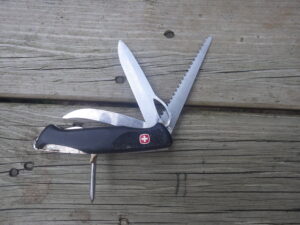
A real handy pocketknife I appreciate, and at a very reasonable price, is made in the French Alps by Opinel. Originally created in 1890 as a simple “peasant’s knife”, it is a rugged piece of work with a beechwood handle, a metal twist-lock, which locks the blade in place, open or closed, and comes in quality carbon or stainless steel blades (I have both but prefer the carbon steel because it is easier to sharpen)). I have used it for field-dressing deer and small game, and can’t fault an Opinel knife in any manner. Opinel also offers a “mushroom knife” with a curve-tipped blade to properly forage for mushrooms such as morels and features a boar-bristle brush on the hilt for dusting off debris. It is my constant companion whenever I am foraging.
There are several high quality “Made in the USA” folding knives available today, and I have my share. Buck, Gerber, Case and Camillus are among my favorites. Probably one of the most innovative folding knife designs is the multi-tool, and my favorites are made in the USA by Leatherman, Gerber and Buck. If I had to pick a single “survivor tool”, it would be a multi-tool manufactured by quality American knife manufacturers. They are very well-made, durable and work exactly as advertised.
A real beauty of pocketknives with two or three blades is if one blade gets dull, there is always a “spare” ready to take over. One of my favorite pocket knife designs is the two-bladed “Trapper”, which features a clip blade and a rounded-tip “spey” blade. One of my most used knives in field-dressing for both deer and small game is a Buck “Trapper” with a pair of three-inch blades. It has done, and continues to do, all that I require in field-dressing. Even when I have a heavy-duty hunting knife on my belt, that Buck “Trapper” is always in my pocket for backup, if needed (the convenience of a compact and light pocketknife), and I never feel underequipped if it is all I have on hand.
Another handy folding knife for upland hunters is called the “bird-knife”, which has a blade and also a “gut-hook” for pulling out the entrails of gamebirds to assist the cooling process while in the field.
As you can see, folding knives certainly come in different configurations for specific needs. When my eldest son, Jake, was deployed to Afghanistan as an Army Light Cavalry Scout, I purchased a Buck “Rescue” knife for him to carry. This specialized folding knife features a stout, 3.5 inch, easy to open (with one hand) blade, with a hilt which features a spike for breaking safety glass, as well as a hooked seatbelt cutter. Its versatile sheath can be fastened to the belt or on a chest strap, and it is an ideal tool not only for combat emergency situations, but also for EMT, Firefighter and law enforcement applications. Of course, I have one in my (obviously growing) “collection”, and it is not a bad tool to have available in a vehicle.
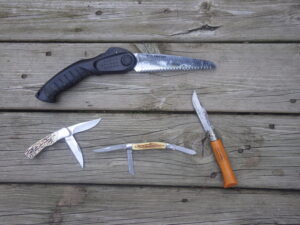
What should also be included are folding saws, with some being compact enough for pocket-carry, and all will fit easily in a backpack. They are real handy and indispensable when something beefier is needed for cutting through wood or bone. My compact Buck folding saw is a constant companion whenever I’m in the boondocks.
Yep, folks, from the Early Iron Age on, convenient and safe-to-carry folding knives have played, and continue to play, an important role in the great outdoors.
- Ladies-only pheasant hunt - November 13, 2025
- Rifles for deer hunting are the most popular in southern Michigan today, but don’t sell shotguns short. - November 1, 2025
- Michigan celebrates 100 years of pheasant hunting - October 23, 2025

